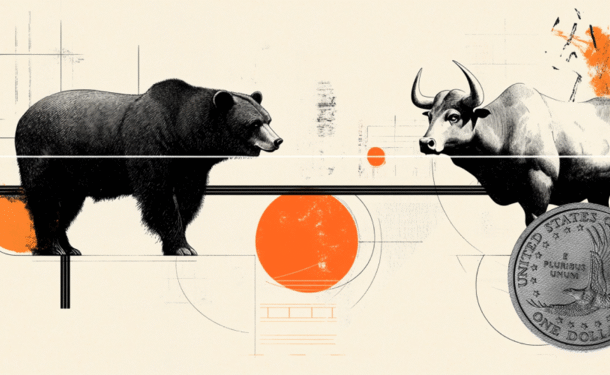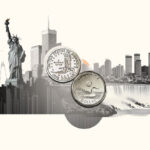
- The US Dollar approaches year-to-date lows at 1.3565 as demand for safe havens wanes.
- Higher Oil prices are acting as support for the Canadian Dollar..
- Markets are positive that the Trump-Carney meeting might bring some advances on a tariff deal.
The USD/CAD recovery attempt seen during Monday’s early trade has failed to find acceptance above 1.3600. The pair retraced gains afterwards, weighed by broad-based US Dollar weakness, and is approaching eight-month lows at 1.3565.
The Greenback opened the week on a moderate positive tone, and trimmed some losses, favoured by a significant reversal on Oil prices. The US Benchmark WTI corrected 3% lower on early trading, retreating from $75.00 to levels right above $71, and dragging the commodity-sensitive CAD down with them.
The US Dollar loses ground as safe-haven demand fades
The pair, however, was unable to extend gains past the 1.3600 level, with fears about the Iran and Israel conflict easing, which has undermined demand for safe-haven assets. Several countries have offered themselves to mediate in the war, and US President Trump is pushing the rivals to find a deal, which has contributed to easing market concerns.
On the other hand, a news report released over the weekend revealed that last week’s agreement between the US and China might have left the key issue of rare earths trade unresolved. This has revived concerns about tariff uncertainty, as the clock ticks towards the July 9 deadline with no significant progress on trade deals.
In Canada, a moderate optimism that the scheduled meeting between US President Trump and Canadian Prime Minister Mark Carney ahead of the G7 summit might help to bring the parties close to some trade compromise is acting as support for the loonie.
Canadian Dollar FAQs
The key factors driving the Canadian Dollar (CAD) are the level of interest rates set by the Bank of Canada (BoC), the price of Oil, Canada’s largest export, the health of its economy, inflation and the Trade Balance, which is the difference between the value of Canada’s exports versus its imports. Other factors include market sentiment – whether investors are taking on more risky assets (risk-on) or seeking safe-havens (risk-off) – with risk-on being CAD-positive. As its largest trading partner, the health of the US economy is also a key factor influencing the Canadian Dollar.
The Bank of Canada (BoC) has a significant influence on the Canadian Dollar by setting the level of interest rates that banks can lend to one another. This influences the level of interest rates for everyone. The main goal of the BoC is to maintain inflation at 1-3% by adjusting interest rates up or down. Relatively higher interest rates tend to be positive for the CAD. The Bank of Canada can also use quantitative easing and tightening to influence credit conditions, with the former CAD-negative and the latter CAD-positive.
The price of Oil is a key factor impacting the value of the Canadian Dollar. Petroleum is Canada’s biggest export, so Oil price tends to have an immediate impact on the CAD value. Generally, if Oil price rises CAD also goes up, as aggregate demand for the currency increases. The opposite is the case if the price of Oil falls. Higher Oil prices also tend to result in a greater likelihood of a positive Trade Balance, which is also supportive of the CAD.
While inflation had always traditionally been thought of as a negative factor for a currency since it lowers the value of money, the opposite has actually been the case in modern times with the relaxation of cross-border capital controls. Higher inflation tends to lead central banks to put up interest rates which attracts more capital inflows from global investors seeking a lucrative place to keep their money. This increases demand for the local currency, which in Canada’s case is the Canadian Dollar.
Macroeconomic data releases gauge the health of the economy and can have an impact on the Canadian Dollar. Indicators such as GDP, Manufacturing and Services PMIs, employment, and consumer sentiment surveys can all influence the direction of the CAD. A strong economy is good for the Canadian Dollar. Not only does it attract more foreign investment but it may encourage the Bank of Canada to put up interest rates, leading to a stronger currency. If economic data is weak, however, the CAD is likely to fall.
Information on these pages contains forward-looking statements that involve risks and uncertainties. Markets and instruments profiled on this page are for informational purposes only and should not in any way come across as a recommendation to buy or sell in these assets. You should do your own thorough research before making any investment decisions. FXStreet does not in any way guarantee that this information is free from mistakes, errors, or material misstatements. It also does not guarantee that this information is of a timely nature. Investing in Open Markets involves a great deal of risk, including the loss of all or a portion of your investment, as well as emotional distress. All risks, losses and costs associated with investing, including total loss of principal, are your responsibility. The views and opinions expressed in this article are those of the authors and do not necessarily reflect the official policy or position of FXStreet nor its advertisers. The author will not be held responsible for information that is found at the end of links posted on this page.
If not otherwise explicitly mentioned in the body of the article, at the time of writing, the author has no position in any stock mentioned in this article and no business relationship with any company mentioned. The author has not received compensation for writing this article, other than from FXStreet.
FXStreet and the author do not provide personalized recommendations. The author makes no representations as to the accuracy, completeness, or suitability of this information. FXStreet and the author will not be liable for any errors, omissions or any losses, injuries or damages arising from this information and its display or use. Errors and omissions excepted.
The author and FXStreet are not registered investment advisors and nothing in this article is intended to be investment advice.
Editors’ Picks

EUR/USD grinds higher above 1.1550 despite Middle East conflict
EUR/USD picks up fresh bids and regains 1.1550 in European trading on Monday amid a renewed US Dollar downtick. Despite the fresh USD selling, traders remain wary about the escalating Israel-Iran conflict as the focus remain on the Fed policy decision due on Wednesday.

GBP/USD advances toward 1.3600 as US Dollar loses ground
GBP/USD extends its rebound toward 1.3600 in Monday’s European session, helped by a fresh selling wave around the US Dollar. Markets seem to look past the deepening Middle East conflict, resorting to position adjustments ahead of the Fed and BoE policy announcements later this week.

Gold price consolidates recent strong gains to the highest level since April
Gold price extends its steady intraday retracement slide from a nearly two-month peak and drops to the $3,400 neighborhood during the early European session on Monday. A generally positive tone around the equity markets is seen as a key factor undermining the safe-haven bullion, which now seems to have snapped a three-day winning streak.

The Best brokers to trade EUR/USD
SPONSORED Discover the top brokers for trading EUR/USD in 2025. Our list features brokers with competitive spreads, fast execution, and powerful platforms. Whether you’re a beginner or an expert, find the right partner to navigate the dynamic Forex market.








